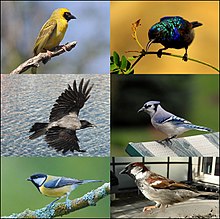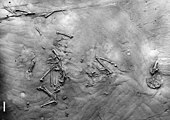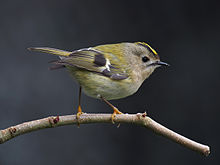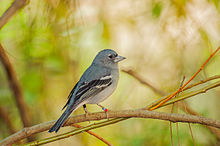Passerine
| Passerine | |
|---|---|

| |
| Clockwise from top right: Palestine sunbird (Cinnyris osea), blue jay (Cyanocitta cristata), house sparrow (Passer domesticus), great tit (Parus major), hooded crow (Corvus cornix), southern masked weaver (Ploceus velatus) | |
| Song of a purple-crowned fairywren (Malurus coronatus) | |
| Scientific classification | |
| Domain: | Eukaryota |
| Kingdom: | Animalia |
| Phylum: | Chordata |
| Class: | Aves |
| Clade: | Psittacopasseres |
| Order: | Passeriformes Linnaeus, 1758 |
| Suborders | |
and see text | |
| Diversity | |
| Roughly 140 families, 6,500 species | |
A passerine (/ˈpæsəraɪn/) is any bird of the order Passeriformes (/ˈpæsərɪfɔːrmiːz/; from Latin passer 'sparrow' and formis '-shaped') which includes more than half of all bird species. Sometimes known as perching birds, passerines generally have an anisodactyl arrangement of their toes (three pointing forward and one back), which facilitates perching.
With more than 140 families and some 6,500 identified species,
Most passerines are
The terms "passerine" and "Passeriformes" are derived from the scientific name of the house sparrow, Passer domesticus, and ultimately from the Latin term passer, which refers to sparrows and similar small birds.
Description
The order is divided into three suborders,

Most passerines are smaller than typical members of other avian orders. The heaviest and altogether largest passerines are the thick-billed raven[9] and the larger races of common raven, each exceeding 1.5 kg (3.3 lb) and 70 cm (28 in). The superb lyrebird and some birds-of-paradise, due to very long tails or tail coverts, are longer overall. The smallest passerine is the short-tailed pygmy tyrant, at 6.5 cm (2.6 in) and 4.2 g (0.15 oz).[10]
Anatomy
The foot of a passerine has three toes directed forward and one toe directed backward, called
The leg of passerine birds contains an additional special adaptation for perching. A tendon in the rear of the leg running from the underside of the toes to the muscle behind the tibiotarsus will automatically be pulled and tighten when the leg bends, causing the foot to curl and become stiff when the bird lands on a branch. This enables passerines to sleep while perching without falling off.[11][12]
Most passerine birds have 12 tail feathers but the
Eggs and nests
The chicks of passerines are
Clutches vary considerably in size: some larger passerines of Australia such as lyrebirds and scrub-robins lay only a single egg, most smaller passerines in warmer climates lay between two and five, while in the higher latitudes of the Northern Hemisphere, hole-nesting species like tits can lay up to a dozen and other species around five or six. The family Viduidae do not build their own nests, instead, they lay eggs in other birds' nests.[citation needed]
The Passeriformes contain several groups of
.Origin and evolution
The evolutionary history of the passerine families and the relationships among them remained rather mysterious until the late 20th century. In many cases, passerine families were grouped together on the basis of morphological similarities that, it is now believed, are the result of
Advances in
The initial diversification of passerines coincides with the separation of the southern continents in the
Fossil record
Earliest passerines
Perching bird
From the
Early European passerines

In Europe, perching birds are not too uncommon in the fossil record from the Oligocene onward, but most are too fragmentary for a more definite placement:
- Wieslochia (Early Oligocene of Frauenweiler, Germany)
- Resoviaornis (Early Oligocene of Wola Rafałowska, Poland)
- Jamna (Early Oligocene of Jamna Dolna, Poland)
- Winnicavis (Early Oligocene of Lower Silesian Voivodeship, Poland)
- Crosnoornis (Early Oligocene of Poland)
- Passeriformes gen. et sp. indet. (Early Oligocene of Luberon, France) – suboscine or basal[b]
- Passeriformes gen. et spp. indet. (Late Oligocene of France) – several suboscine and oscine taxa[24][19]
- Passeriformes gen. et spp. indet. (Middle Miocene of France and Germany) – basal?[c]
- Passeriformes gen. et spp. indet. (Sajóvölgyi Middle Miocene of Mátraszőlős, Hungary) – at least 2 taxa, possibly 3; at least one probably Oscines.[d]
- Passeriformes gen. et sp. indet. (Middle Miocene of Felsőtárkány, Hungary) – oscine?[e]
- Passeriformes gen. et sp. indet. (Late Miocene of Polgárdi, Hungary) – Sylvioidea (Sylviidae? Cettiidae?)[27]
That suboscines expanded much beyond their region of origin is proven by several fossils from Germany such as a presumed broadbill (
American fossils
In the
Systematics and taxonomy
| |||||||||||||||
| Phylogenetic relationship of the suborders within the Passeriformes. The numbers are from the list published by the International Ornithologists' Union in January 2020.[1][30] |
The Passeriformes is currently divided into three suborders:
Major "
Taxonomic list of Passeriformes families
This list is in taxonomic order, placing related families next to one another. The families listed are those recognised by the International Ornithologists' Union (IOC).[1] The order and the division into infraorders, parvorders, and superfamilies follows the phylogenetic analysis published by Carl Oliveros and colleagues in 2019.[30][g] The relationships between the families in the suborder Tyranni (suboscines) were all well determined but some of the nodes in Passeri (oscines or songbirds) were unclear owing to the rapid splitting of the lineages.[30]
Suborder Acanthisitti
- Acanthisittidae: New Zealand wrens
Suborder Tyranni (suboscines)
Infraorder Eurylaimides: Old World suboscines
-
- Philepittidae: asities
- Eurylaimidae: typical broadbills
- Calyptomenidae: African and green broadbills
- Sapayoidae: broad-billed sapayoa
- Pittidae: pittas
Infraorder Tyrannides: New World suboscines
Parvorder Furnariida
-
- Melanopareiidae: crescentchests
- Conopophagidae: gnateaters and gnatpittas
- Thamnophilidae: antbirds
- Grallariidae: antpittas
- Rhinocryptidae: typical tapaculos
- Formicariidae: antthrushes
- Furnariidae: ovenbirds and woodcreepers
Parvorder Tyrannida
-
- Pipridae: manakins
- Cotingidae: cotingas
- Tityridae: tityras and allies
- Tyrannidae: tyrant flycatchers
Suborder Passeri (oscines or songbirds)

- Atrichornithidae: scrub-birds
- Menuridae: lyrebirds
- Climacteridae: Australian treecreepers
- Ptilonorhynchidae: bowerbirds
- Maluridae: fairywrens, emu-wrens and grasswrens
- Dasyornithidae: bristlebirds
- Pardalotidae: pardalotes
- Acanthizidae: scrubwrens, thornbills, and gerygones
- Meliphagidae: honeyeaters
- Pomatostomidae: pseudo-babblers
- Orthonychidae: logrunners
- Cinclosomatidae: jewel-babblers, quail-thrushes
- Campephagidae: cuckooshrikes and trillers
- Mohouidae: whiteheads
- Neosittidae: sittellas
- Superfamily Orioloidea[h]
- Psophodidae: whipbirds
- Eulacestomatidae: wattled ploughbill
- Falcunculidae: shriketit
- Oreoicidae: Australo-Papuan bellbirds
- Paramythiidae: painted berrypeckers
- Vireonidae: vireos
- Pachycephalidae: whistlers
- Oriolidae: Old World orioles and figbirds
- Superfamily Malaconotoidea[i]

- Machaerirhynchidae: boatbills
- Artamidae: woodswallows, butcherbirds, currawongs, and Australian magpie
- Rhagologidae: mottled berryhunter
- Malaconotidae: puffback shrikes, bush shrikes, tchagras, and boubous
- Pityriaseidae: bristlehead
- Aegithinidae: ioras
- Platysteiridae: wattle-eyes and batises
- Vangidae: vangas
- Rhipiduridae: fantails
- Dicruridae: drongos
- Monarchidae: monarch flycatchers
- Ifritidae: blue-capped ifrit
- Paradisaeidae: birds-of-paradise
- Corcoracidae: white-winged chough and apostlebird
- Melampittidae: melampittas
- Laniidae: shrikes
- Platylophidae: jayshrike
- Corvidae: crows, ravens, and jays
- Infraorder Passerides – previously known as the parvorder Passerida[33]
- Cnemophilidae: satinbirds
- Melanocharitidae: berrypeckers and longbills
- Callaeidae: New Zealand wattlebirds
- Notiomystidae: stitchbird
- Petroicidae: Australian robins
- Eupetidae: rail-babbler
- Picathartidae: rockfowl
- Chaetopidae: rock-jumpers

-
- Hyliotidae: hyliotas
- Stenostiridae: fairy flycatchers
- Paridae: tits, chickadees and titmice
- Remizidae: penduline tits
- Panuridae: bearded reedling
- Alaudidae: larks
- Nicatoridae: nicators
- Macrosphenidae: crombecs and African warblers
- Cisticolidae: cisticolas and allies

- Superfamily Locustelloidea
- Acrocephalidae: reed warblers, Grauer's warbler and allies
- Locustellidae: grassbirds and allies
- Donacobiidae: black-capped donacobius
- Bernieridae: Malagasy warblers
- —
- Pnoepygidae: wren-babblers
- Hirundinidae: swallows and martins

- Superfamily Sylvioidea
- Pycnonotidae: bulbuls
- Sylviidae: sylviid babblers
- Paradoxornithidae: parrotbills and myzornis
- Zosteropidae: white-eyes
- Timaliidae: tree babblers
- Leiothrichidae: laughingthrushes and allies
- Alcippeidae: Alcippe fulvettas
- Pellorneidae: ground babblers
- Superfamily Aegithaloidea
- Phylloscopidae: leaf-warblers and allies
- Hyliidae: hylias
- Aegithalidae: long-tailed tits or bushtits
- Scotocercidae: streaked scrub warbler
- Cettiidae: Cettia bush warblers and allies
- Erythrocercidae: yellow flycatchers
- Parvorder Muscicapida – previously known as the superfamily Muscicapoidea[33]
- Superfamily Bombycilloidea
- Dulidae: palmchat
- Bombycillidae: waxwings
- Ptiliogonatidae: silky flycatchers
- Hylocitreidae: hylocitrea
- Hypocoliidae: hypocolius
- †Mohoidae: oos

- Superfamily Muscicapoidea
- Elachuridae: spotted elachura
- Cinclidae: dippers
- Muscicapidae: Old World flycatchers and chats
- Turdidae: thrushes and allies
- Buphagidae: oxpeckers
- Sturnidae: starlings and rhabdornis
- Mimidae: mockingbirds and thrashers
- —
- Regulidae: goldcrests and kinglets
- Superfamily Certhioidea
- Tichodromidae: wallcreeper
- Sittidae: nuthatches
- Certhiidae: treecreepers
- Polioptilidae: gnatcatchers
- Troglodytidae: wrens
- Parvorder Passerida – previously known as the superfamily Passeroidea[33]
- Promeropidae: sugarbirds
- Modulatricidae: dapple-throat and allies
- Nectariniidae: sunbirds
- Dicaeidae: flowerpeckers
- Chloropseidae: leafbirds
- Irenidae: fairy-bluebirds
- Peucedramidae: olive warbler
- Urocynchramidae: Przewalski's finch
- Ploceidae: weavers
- Viduidae: indigobirds and whydahs
- Estrildidae: waxbills, munias and allies
- Prunellidae: accentors
- Passeridae: Old World sparrows and snowfinches
- Motacillidae: wagtails and pipits
- Fringillidae: finches and euphonias
- Superfamily Emberizoidea – previously known as the New World
- Rhodinocichlidae: rosy thrush-tanager
- Calcariidae: longspurs and snow buntings
- Emberizidae: buntings
- Cardinalidae: cardinals
- Mitrospingidae: mitrospingid tanagers
- Thraupidae: tanagers and allies
- Passerellidae: New World sparrows, bush tanagers
- Parulidae: New World warblers
- Icteriidae: yellow-breasted chat
- Icteridae: grackles, New World blackbirds, and New World orioles
- Calyptophilidae: chat-tanagers
- Zeledoniidae: wrenthrush
- Teretistridae: Cuban warblers[m]
- Nesospingidae: Puerto Rican tanager
- Spindalidae: spindalises
- Phaenicophilidae: Hispaniolan tanagers
Phylogeny
Relationships between living Passeriformes families based on the phylogenetic analysis of Oliveros et al (2019).
| Passeriformes |
| ||||||||||||||||||||||||||||||||||||||||||||||||||||||||||||||||||||||||||||||||||||||||||||||||||||||||||||||||||||||||||||||||||||||||||||||||||||||||||||||||||||||||||||||||||||||||||||||||||||||||||||||||||||||||||||||||||||||||||||||||||||||||||||||||||||||||||||||||||||||||||||||||||||||||||||||||||||||||||||||||||||||||||||||||||||||||||||||||||||||||||||||||||||||||||||||||||||||||||||||||||||||||||||||||||||||||||||||||||||||||||||||||||||||||||||||||||||||||||||||||||||||||||||||||||||||||||||||||||||||||||||||||||||||||||||||||||||||||||||||||||||||||||||||||||||||||||||||||||||||||||||||||||||||||||||||||||||||||||||||||||||||||||||||||||||||||||||||||||||||||||||||||||||||||||||||||||||||||||||||||||||||||||||||||||||||||||||||||||||||||||||||||||||||||||||||||||||||||||||||||||||||||||||||||||||||||||||||||||||||||||||||||||||||||||||||||||||||||||||||||||||||||||||||||||||||||||||||||||||||||||||||||||||||||||||||||||||||||||||||||
Explanatory notes
- Pnoepygidae. For the monophyly of the "true wrens", Troglodytidae, see Barker 2004.[15]
- MNHN SA 1259–1263: tibiotarsus remains of small, possibly basal Passeriformes.[18]
- ^ A humerus diaphysis piece of a swallow-sized passerine.[27]
- ^ Distal right humerus, possibly suboscine.[28][29]
- ^ The order of the families within the superfamily Orioloidea is uncertain.[30]
- ^ The order of the families within the superfamily Malaconotoidea is uncertain.[30]
- ^ The order of the families within the superfamily Corvoidea is uncertain.[30]
- ^ The taxonomic sequence of the superfamilies Locustelloidea, Sylvioidea and Aegithaloidea is uncertain, although the order of the families within each of the superfamilies is well determined.[30]
- ^ The order of some of the families within the superfamily Emberizoidea is uncertain.[30]
- Zeledoniidae.[34]
References
- ^ Rasmussen, Pamela, eds. (2020). "Family Index". IOC World Bird List Version 10.1. International Ornithologists' Union. Retrieved 26 April 2020.
- ^ a b Ericson, P.G.P. et al. (2003) Evolution, biogeography, and patterns of diversification in passerine birds. J. Avian Biol, 34:3–15.
- ^ a b c Selvatti, A.P. et al. (2015) "A Paleogene origin for crown passerines and the diversification of the Oscines in the New World". Molecular Phylogenetics and Evolution, 88:1–15.
- PMID 11839199.
- ^ PMID 11839192.
- ^ PMID 26824065.
- ISBN 9781421415901.
- ^ Winkler, D. W., S. M. Billerman, and I.J. Lovette (2020). Lyrebirds (Menuridae), version 1.0. In Birds of the World (S. M. Billerman, B. K. Keeney, P. G. Rodewald, and T. S. Schulenberg, Editors). Cornell Lab of Ornithology, Ithaca, New York, US. https://doi.org/10.2173/bow.menuri1.01
- ^ Madge, S. (2020). Thick-billed Raven (Corvus crassirostris), version 1.0. In Birds of the World (J. del Hoyo, A. Elliott, J. Sargatal, D. A. Christie, and E. de Juana, Editors). Cornell Lab of Ornithology, Ithaca, New York, US. https://doi.org/10.2173/bow.thbrav1.01
- ^ Clock, B. (2020). Short-tailed Pygmy-Tyrant (Myiornis ecaudatus), version 1.0. In Birds of the World (J. del Hoyo, A. Elliott, J. Sargatal, D. A. Christie, and E. de Juana, Editors). Cornell Lab of Ornithology, Ithaca, New York, US. https://doi.org/10.2173/bow.stptyr1.01
- ISBN 9780761426936.
- ISBN 0521362059.
- ^ Jones, D. (2008) "Flight of fancy". Australian Geographic, (89), 18–19.
- S2CID 205998536.
- PMID 15062790.
- .
- ^ doi:10.1071/MU97004.
- ^ S2CID 73668280.
- ^ .
- S2CID 85167051.
- ^ Bochenski, Z.M., Tomek, T., Bujoczek, M. (2021) A new passeriform (Aves: Passeriformes) from the early Oligocene of Poland sheds light on the beginnings of Suboscines. J Ornithol. https://doi.org/10.1007/s10336-021-01858-0
- S2CID 85230857.
- ^ Roux, T. (2002). "Deux fossiles d'oiseaux de l'Oligocène inférieur du Luberon" [Two bird fossils from the Lower Oligocene of Luberon] (PDF). Courrier Scientifique du Parc Naturel Régional du Luberon. 6: 38–57.
- .
- ^ Gál, Erika; Hír, János; Kessler, Eugén & Kókay, József (1998–99). "Középsõ-miocén õsmaradványok, a Mátraszõlõs, Rákóczi-kápolna alatti útbevágásból. I. A Mátraszõlõs 1. lelõhely" [Middle Miocene fossils from the sections at the Rákóczi chapel at Mátraszőlős. Locality Mátraszõlõs I.]. Folia Historico Naturalia Musei Matraensis. 23: 33–78.
- ^ Gál, Erika; Hír, János; Kessler, Eugén; Kókay, József & Márton, Venczel (2000). "Középsõ-miocén õsmaradványok a Mátraszõlõs, Rákóczi-kápolna alatti útbevágásból II. A Mátraszõlõs 2. lelõhely" [Middle Miocene fossils from the section of the road at the Rákóczi Chapel, Mátraszõlõs. II. Locality Mátraszõlõs 2]. Folia Historico Naturalia Musei Matraensis. 24: 39–75.
- ^ a b Hír, János; Kókay, József; Venczel, Márton; Gál, Erika & GKessler, Eugén (2001). "Elõzetes beszámoló a felsõtárkányi "Güdör-kert" n. õslénytani lelõhelykomplex újravizsgálatáról" [A preliminary report on the revised investigation of the paleontological locality-complex "Güdör-kert" at Felsõtárkány, Northern Hungary] (PDF). Folia Historico Naturalia Musei Matraensis. 25: 41–64. Archived (PDF) from the original on 16 March 2021.
- ^ Noriega, Jorge I. & Chiappe, Luis M. (1991). "El más antiguo Passeriformes de America del Sur. Presentation at VIII Journadas Argentinas de Paleontologia de Vertebrados" [The most ancient passerine from South America]. Ameghiniana. 28 (3–4): 410.
- (PDF) from the original on 13 March 2014.
- ^ PMID 30936315.
- ^ The former does not even have recognized subspecies, while the latter is one of the most singular birds alive today. Good photos of a bearded reedling are for example here Archived 16 October 2007 at the Wayback Machine and here Archived 31 July 2008 at the Wayback Machine.
- ISBN 978-0-9568611-2-2.
- ^ ISBN 978-0-9568611-2-2.
- ^ PMID 23229025.
- ISBN 978-0-9568611-2-2.
Further reading
- Alström, Per; Ericson, Per G.P.; Olsson, Urban & Sundberg, Per (2006). "Phylogeny and classification of the avian super-family Sylvioidea". PMID 16054402.
- Barker, F. Keith; Barrowclough, George F. & Groth, Jeff G. (2002). "A phylogenetic hypothesis for passerine birds: taxonomic and biogeographic implications of an analysis of nuclear DNA sequence data" (PDF). PMID 11839199. Archived from the original(PDF) on 11 May 2008. Retrieved 14 February 2008.
- Barker, F. Keith; Cibois, Alice; Schikler, Peter A.; Feinstein, Julie & Cracraft, Joel (2004). "Phylogeny and diversification of the largest avian radiation".
- Beresford, P.; Barker, F.K.; Ryan, P.G. & Crowe, T.M. (2005). "African endemics span the tree of songbirds (Passeri): molecular systematics of several evolutionary 'enigmas'". PMID 15888418.
- Cibois, Alice; Slikas, Beth; Schulenberg, Thomas S. & Pasquet, Eric (2001). "An endemic radiation of Malagasy songbirds is revealed by mitochondrial DNA sequence data". S2CID 23065097.
- Ericson, Per G.P. & Johansson, Ulf S. (2003). "Phylogeny of Passerida (Aves: Passeriformes) based on nuclear and mitochondrial sequence data". PMID 12967614.
- Johansson, Ulf S. & Ericson, Per G.P. (2003). "Molecular support for a sister group relationship between Pici and Galbulae (Piciformes sensu Wetmore 1960)" (PDF). (PDF) from the original on 24 May 2006.
- Jønsson, Knud A. & Fjeldså, Jon (2006). "A phylogenetic supertree of oscine passerine birds (Aves: Passeri)". S2CID 85317440.
- Lovette, Irby J. & Bermingham, Eldredge (2000). "c-mos Variation in Songbirds: Molecular Evolution, Phylogenetic Implications, and Comparisons with Mitochondrial Differentiation". PMID 11018162.
- Mayr, Gerald (2016). Avian evolution: the fossil record of birds and its paleobiological significance. Chichester, West Sussex: John Wiley & Sons. ISBN 978-1-119-02076-9.
- Raikow, Robert J. (1982). "Monophyly of the Passeriformes: test of a phylogenetic hypothesis". The Auk. 99 (3): 431–445. doi:10.1093/auk/99.3.431 (inactive 31 January 2024).)
{{cite journal}}: CS1 maint: DOI inactive as of January 2024 (link
External links
 The dictionary definition of passerine at Wiktionary
The dictionary definition of passerine at Wiktionary Media related to Passeriformes at Wikimedia Commons
Media related to Passeriformes at Wikimedia Commons Data related to Passeriformes at Wikispecies
Data related to Passeriformes at Wikispecies
